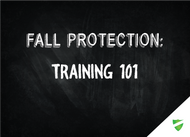Falls from height are preventable with the proper training, yet in 2020, more than 351 people suffered fatal falls in the construction industry. Yeah, a slip at home might shatter your pride, but a fall at a worksite can destroy your livelihood. It's just not worth it!
Reduce risk and increase safety by properly training employees on the importance of how to use fall protection equipment properly.
What is fall protection training?
Fall protection training involves making employees familiar with workplace hazards and preparing them for situations where they could be in danger of a fall. Failure to provide adequate fall protection training is one of the most frequently cited OSHA violations.
Teaching your employees about the risks of falling at height and how to use a harness, SRL, or anchorage connection doesn’t have to be complicated or difficult.
We even wrote this beginner's guide to get you started...
Fall Protection Equipment: A Simple Guide to What is What
Generally, there are four levels of fall protection training:
- Awareness-level training - During this type of training, a specialist or skilled employee will provide a basic understanding of how to use fall protection equipment and the hazards of the workplace. This training is not enough to adequately educate employees. This is what we'd call a "nice-to-know" overview.
- Authorize-user training – Any employee who is at risk of a fall should complete this training. Not only do the lessons meet OSHA’s compliance guidelines, but they will also specify which dangers workers will face in their industry.
- Competent-person training – This training is designed for supervisors or a designated "competent person" who are required to have advanced knowledge of workplace dangers. The in-depth instruction covers the appropriate use of equipment, how to address fall hazards, and fall risk solutions.
- Qualified-person training – It is best practice for an employer to designate someone as a qualified person who can help solve technical issues. Trust us, you don’t want the guy who is into boating assuming he knows how to certify your anchor point. Qualified people are specifically educated to verify fall safety equipment and even design fall safety systems.
Usually, your employee's level of training required depends on their job status.
How often is fall protection training required?
As an employer it's your responsibility to train each employee on fall protection and inform them of fall hazards they may encounter while at work. However, OSHA leaves the timeline and implementation of the training up to the discretion of the qualified instructor. If a trained employee didn’t quite seem to grasp the initial training, the OSHA training requirements for fall protection recommend that the employer retrain them. Employees should also be retrained if there are changes in the workplace or fall protection systems.
Who can give fall protection training?
Fall protection training should be given by a qualified person. We’re sure all of your employees are talented, but let’s not assume the first one to volunteer will be an adequate instructor.
OSHA 1926.32 defines qualified as “one who, by possession of a recognized degree, certificate, or professional standing, or who by extensive knowledge, training, and experience, has successfully demonstrated his ability to solve or resolve problems relating to the subject matter, the work, or the project.”
It is best to choose someone that earned a "qualified person" designation from a qualified-person training program. Or you can partner with a service provider like Safety Services, Inc. who can offer you customized training lead by expert fall protection equipment manufacturers.
Does fall protection training expire?
Training may expire depending on the origin of the instruction. OSHA considers an employee to be fully trained after completing the courses one time, but you always have a duty to retrain employees that seem confused of if there are any changes. ANSI Z359 recommends retraining every two years, but employers can decide if that timeframe makes sense for their workers. Lastly, many manufacturers offer safety training certificates that usually expire after two years.
You don’t have to go at it alone!
Even after completing training independently, employers often have questions when determining the best products for their employees. At Safety Services Inc. we are ready and available to assist your business in navigating the world of personal protective equipment.
Contact us about how we can help you today.


